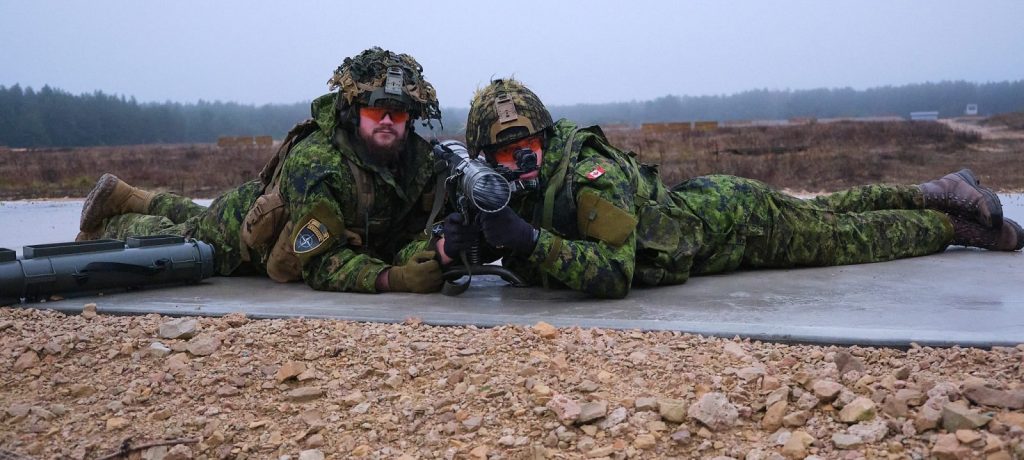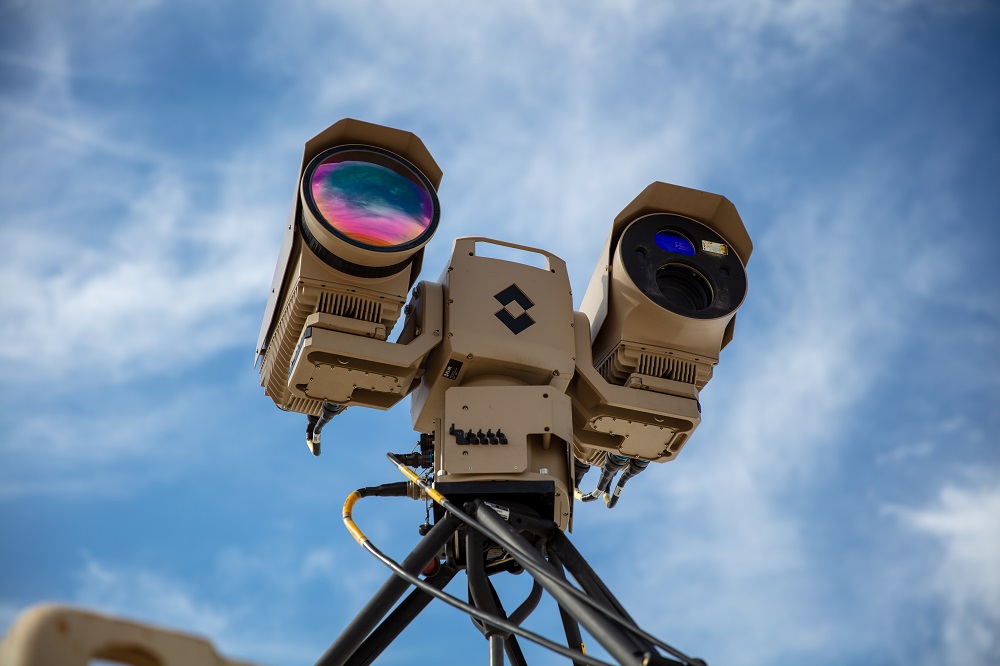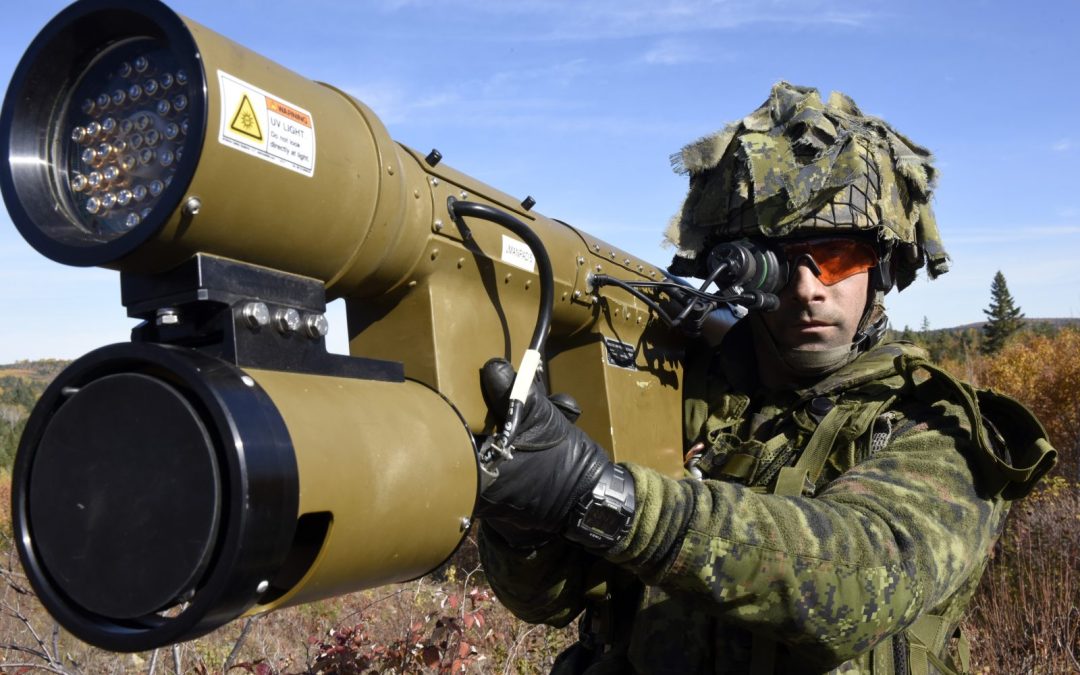by Staff
We’re not quite into “For the want of a nail … the kingdom was lost” territory, to paraphrase Benjamin Franklin. But for want of anti-tank weapons, air defence and counter-uncrewed aerial systems (UAS), defending troops, vehicles and headquarters in a future battle would be exceedingly difficult.
As the Army begins to scale the 10-nation enhanced Forward Presence (eFP) Battle Group in Latvia to the strength of a multinational brigade, it must fill at least three capability gaps to meet that NATO obligation — portable anti-tank missile systems, air defence and counter UAS.
“Canada does not have some of those capabilities that would inherently be required in a brigade,” observed Colonel Vince Kirstein, commander of Task Force Latvia, responsible for negotiating with contributing nations on the composition and eventual combat mix of the brigade. “Typically, air defence and anti-tank weapons are going to be a key part of this.”
The brutal lessons of the war in Ukraine and the collective experience of the battle group since it was stood up in 2017, have highlighted those shortfalls in the battle group’s capability. So, like Chinook helicopters, M777 howitzers, up-armoured LAVs, and strategic airlift for the war in Afghanistan, the three have been deemed urgent operational requirements (UOR) and are being fast-tracked through the procurement system for delivery to the battle group by the summer of 2024.
“The current situation in Europe is a threat to the global security balance. The Army must have the critical enablers that the modern battlefield demands,” said Army commander Lieutenant-General Jocelyn Paul. “These capabilities are needed to ensure freedom of action and to protect our soldiers deployed as part of Operation Reassurance. The UOR designation is not a way to bypass the normal procurement process. And we recognize it cannot be a permanent solution to capability shortfalls. We’re going to make every effort to mitigate the impact on existing projects.”
Of the three, the portable anti-X missile system (PAXM) will likely be the most straightforward to acquire and integrate into operations. The Army has considerable experience with anti-armour weapons. The BMG-71 TOW wire-guided missile system is the primary anti-tank weapon of the mechanized brigade groups, and Army inventory includes the Carl Gustaf recoilless rifle and the M72 LAW rocket propelled grenade launcher.
None, however, is “sufficient for the role that [is required] in Op Reassurance,” observed Colonel Dave MacIntyre, Director of Land Requirements (DLR).

Photo: CAF Latvia
In addition to a weapon system able to destroy a main battle tank that is truly soldier portable, from the company down to the section level in the infantry, and can be operated by a two-person crew, the Army is seeking a missile with a minimum range of 2,500 metres, between the approximately 350 metres of the Carl Gustaf and 3,500 metres of the TOW.
“There are a couple of fourth and fifth generation anti-tank guided missile systems available that would bring a lot of new capability to the Army,” said MacIntyre. A request for proposals (RFP) was issued in March and a contract could be awarded by mid-2023.
The intent of the UOR is not to replace either the Carl G or the TOW yet. The government donated as many as 100 older-model Gustaf M2 line-of-sight weapons to Ukraine last spring and will likely seek to replace that inventory with the much newer M4 variant or a similar system. And the Army investment plan includes an anti-tank guided missile replacement (ATGMR) project, identified in the government’s 2017 defence policy, that is proceeding through the procurement process.
Rather, the capability, which would include missiles, simulators, and any necessary training, would go directly to the battle group in Latvia as one of its primary portable anti-tank guided weapons.
At the same time, it will inform the DLR project team about those future anti-tank requirements. “We’ll learn lessons similar to a buy-and-try, hopefully with more of an operational focus,” said MacIntyre. “That will help inform ATGMR and the direction it goes when it does move into the procurement stage.”
Air defence and counter UAS (CUAS), though not interdependent, are considered a layered response to an aerial threat from drones and long-range artillery that has been on full display in Ukraine and in the ongoing conflict between Armenia and Azerbaijan.
“These two systems are being acquired with that in mind,” said MacIntryre. “The two effects are complementary, but they won’t always necessarily be working in concert with each other.”
For air defence, the aim is to deliver a very short-range (VSHORAD) interceptor, either tripod or shoulder mounted, able to defend against attack aviation, close air support aircraft, and various small and midsized UAS. It must also connect with Canadian and allied air space coordination centres and other networks for a comprehensive air picture. The system will reside with the 4th Artillery Regiment (General Support) as “a new structure item,” he said.
While air defence provides the hard defeat of aerial threats, including from hand launched Class 1 UAS and larger, a mounted or dismounted CUAS system will detect, identify, track, and then degrade or defeat mini and small drones through “other means” such as disabling and jamming.
“Similar to air defence, CUAS has an element of complexity associated with air space control, identifying friend or foe, but the way those technology blocks fit together is why we have two separate projects,” MacIntyre explained. “They look at different problems, but at the same time, they need to be layered and work together.”

From September 12th to October 7th 2022 at the Suffield Research Centre of Defence Research and Development Canada (DRDC), 14 private sector participant companies demonstrate innovative technology for detecting and/or defeating unmanned aerial system (UAS) threats during the Counter Unmanned Aerial Systems (CUAS) Sandbox as part of the Department of National Defence (DND) Innovation for Defence Excellence and Security (IDEaS) program.
CUAS will be acquired in phases, first as a dismounted and fixed site system, and then as a vehicle-mounted fully integrated system. Since the UAS threat is also a concern for the Navy defending port operations and the Air Force defending airfields, both services will also receive systems through the UOR process.
The Army is analyzing options for both the air defence and CUAS projects and anticipates awarding contracts in 2023 and 2024. Both systems are expected to reach initial operating capability by the summer of 2024.
Critically, both will also help to reinvigorate the Army’s air defence community. Though the last air defence system — the Oerlikon dual-purpose short range surface-to-air and anti-tank missile system (ADATS), mounted on an M113 chassis — lapsed in 2012, the 4th Regiment (GS) has retained the expertise “to be able to start this from a walk,” MacIntyre said. “It won’t be from a standstill.”
The regiment, part of the 6th Canadian Combat Support Brigade, based in Gagetown, New Brunswick, currently provides the Air Space Coordination Centre (ASCC), the medium range radar, and the CU172 Blackjack small UAS, and will deploy a battery once the air defence systems are delivered.
“They have maintained our ability to plan and execute air defence operations in a coalition environment, and the fielding of the (recently modernized) ASCC vehicle, a brigade level asset, which forms that communications hub for an air defence capability,” MacIntyre noted. “They will form the basis of the air defence troop and it will become the centre of excellence for air defence once again.”
Moreover, the UOR acquisition will allow the regiment to spend time with the system before the Ground-Based Air Defence (GBAD) project, also navigating its way through the procurement process, delivers in the late 2020s. In addition to the “shooter” to counter rockets, artillery, mortars, air-to-surface missiles, bombs and drones, GBAD will acquire a sensor suite, fire control software, networked command and control, and immersive training, including upgrades to ranges.
“The approach isn’t to use this UOR procurement to enable GBAD,” said MacIntyre. “But we will certainly be looking for the lessons learned on how it’s employed, some of the technical limitations, how effective the effectors are in an operational space, and the communications and network integration, which will grow over time. I think it will help to de-risk the overall GBAD project.”


Thanks for the article. Can someone with a background in these matters help me better understand a couple of things?
1) Are the UORs really good news? Seems that the same HR used to advance the larger projects to buy stuff for the whole army will have to down tools to staff the UORs. This will delay those larger projects even more than they already are.
(This sentence is incorrect: “And the Army investment plan includes an anti-tank guided missile replacement (ATGMR) project, identified in the government’s 2017 defence policy, that is proceeding through the procurement process.” I hear that project has not yet seen any progress at all. It’s quite stuck in the starting gate.)
2) Why are munitions being mentioned as a target set in the GBAD program? Is it cost-effective to use (what I assume will be) expensive interceptors to knock down cheap munitions like mortars and arty rounds? That strikes me as unsustainable. Do any of our allies specify these as part of their target sets? Do the Ukrainians even attempt that? Sounds like a hold-over from Afghanistan…
3) “The UOR designation is not a way to bypass the normal procurement process.” LGen Paul
But what if the “normal procurement process” is dysfunctional and can’t render timely results? If there is no overseas mission to spur UORs, what other avenues are available to speed up procurement?
Thanks in advance!
Interesting article and it offers a glimmer of hope for the Army, but the fact of the matter is that the politicians have grossly failed Canadian Army. These systems should have been purchased years ago. People reading this article should ask themselves if anything will change regarding the CAF under the current gov’t. It won’t. If you care about the Canadian Army and the people that serve in it, start talking to your friends and neighbors about making a change in Ottawa. Even it’s just a little bit, talk to people about the need go in a different direction. Every little bit helps. About the alternative to the current gov’t, their history re: funding the CAF isn’t illustrious, but I can’t get any worse than the neglect we’ve seen over the past eight years. Speak up folks and make change.